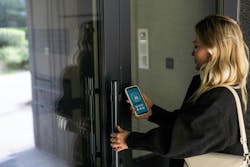This article originally appeared in the July 2024 issue of Security Business magazine. Don’t forget to mention Security Business magazine on LinkedIn and @SecBusinessMag on Twitter if you share it.
Today’s facility managers face the challenge of deploying connected access within buildings effectively. The goal is to enable employees and tenants to use smartphones or smartwatches as new types of “keys” to unlock places, spaces, and things within a facility.
The widespread availability of digital NFC wallets on major mobile platforms – including iPhones, Apple Watches, and Android devices – has made connected access a timely and unavoidable topic. With access credentials in NFC wallets supported by Apple and Google, users can tap into the ease and flexibility of using an access pass in their digital wallets, similar to how they already handle payments, airline tickets, and loyalty programs.
To make this possible at corporations with one to multiple sites and across commercial estate portfolios, there are a handful of practical insights, tips, and strategies to help integrators help clients such as facility managers, heads of real estate and security administrators implement NFC-enabled mobile keys for seamless access.
Common vs. Best Practices
There are a series of common vs. best practices to ensure employees and tenants can easily use their mobile devices to access buildings, parking garages, elevators, turnstiles, lockers, amenities, and enterprise resources, among other typical facility features.
Common practices of the past were often based on outdated assumptions and lacked the necessary balance of creating a great user experience while enhancing security at the same time. Today’s best practices consider the shift away from the notion of “access control” in favor of “access enablement,” which ensures the right people have access to the right places and spaces, at the right time.
This new paradigm seeks to deliver on-demand, self-service access that combines a delightful, connected access experience, automation, stronger governance, and tighter security – all without compromise. It is the difference between trying to control the population (legacy) and empowering people (connected access).
In recent years, common practices of making mobile access available using older technologies have led to inconsistent user experiences and limited options. Consequently, many organizations have been slow to adopt the use of smartphones or smartwatches for access.
Pitfalls to Avoid
Integrators must help facility managers understand “what not to do” in today’s new reality of access credentials in NFC wallets, to avoid repeating the mistakes of early adopters of Bluetooth-enabled mobile keys. Here are a few pitfalls to avoid:
Complex authentication processes: Do not require users to go through a complex, manual process to authenticate before being able to use their Apple or Android device to gain access to places and spaces. A user usually does not have the patience to receive an email with a code, then manually type it in, and wait to complete the authentication process. That is laborious and time-consuming. Additionally, users do not want to stop at a reception deck to have their mobile credential authorized, which defeats the purpose of the process.
Inconsistent and unreliable experiences: There is no reason to expect anything less than a fast, easy, and seamless access experience when using mobile devices. Seeing a person waving a phone or a smartwatch at a door reader multiple times to get in is a poor experience and should never become the norm; instead, access credentials in NFC wallets make it possible for users to have identical fast and reliable access experiences with their mobile device as they do with a card or keyfob.
Fragmented mobile use-cases: Avoid enabling mobile access for just a few, limited parts of a facility, requiring employees and tenants to have multiple credentials for access to different places and things. This inconvenience can discourage users from using the mobile credentials. Employees and tenants have become too familiar with this kind of scenario, which prevents a seamless street-to-seat access journey.
Best Practices for Connected Access
Ultimately, best practices are the pathway to superior business outcomes and exceptional user experiences. Embracing best practices for connected access in a facility will eliminate legacy challenges and potential misperceptions about mobile access. Some of the most important keys to success for mobile access in a facility today include leveraging automated onboarding and workflows, and maximizing the value of NFC access in digital wallets for street-to-seat, connected access.
Automated onboarding: A first-class digital native experience – such as using Apple Wallet or Google Wallet for access – is now considered an amenity in the workplace. It is a best practice to offer employees and tenants on-demand, self-service access to a facility, which also increases operational and workflow efficiencies for administrators. The user can bypass the front desk and have on-demand access to the right places, spaces, and things at the right time. It saves time, effort, and costs, while enhancing security and improving privacy.
The employee or tenant’s access pass is provisioned into their digital NFC wallet the same way a person would get an airline boarding pass – users no longer have to wait for access to be granted. They simply download their multi-purpose workplace experience app, onboard using their standard single sign-on…just like they do with their computer log-in or email log-in, and add their pass to their NFC wallet. From there, they have connected access to everything based on permissions preset by the administrator.
Leverage zero-trust principles: For administrators, stress the importance of physical access being treated the same way as enterprise IT access, including applying standard zero-trust principles. For example, there should be high assurance that the person accessing a place, space, or thing is an authenticated user with a trusted device as a precondition for provisioning a pass with their specific permissions in their mobile device’s NFC wallet. It is a best practice to offer a streamlined, rapid process that emulates the logical access authentication process with a single entry to enable access to places, spaces, and things for the desired time.
Ensure a 100% mobile access use-case: Mobile devices should work everywhere plastic cards do; in fact, it is vital to create an access experience that emulates the traditional contactless card experience that users are already accustomed to. NFC technology works 100 percent of the time, thereby giving users higher confidence in using a smartphone or smartwatch to reliably access buildings and resources. The best practice is to deploy NFC-based mobile credentials to be used everywhere smartcards are used – and beyond, since employees and tenants want to use their phones for everything. Additionally, access should be consistent across the base building and corporate office spaces, delivering an unfettered mobile access experience. When mobile access works everywhere for authorized users, it enables a true “street-to-seat” user experience.
Cross-platform integration and the simplicity of an NFC access badge in Apple Wallet and Google Wallet help create this seamless, friction-free journey. From connected access to parking, base building turnstiles and elevators, amenity spaces, corporate office suites, and enterprise resources, it’s become best practice to unlock the true value of a total, streamlined workplace experience – staying ahead of the most relevant trends for a modern facility.
Advantages of NFC Mobile Access for Security and User Experience
These best practices are poised to shape the future of facilities as more facility managers aim to provide users with experiences that enrich their digital-first lifestyles, while delivering the “cool factor” of using a smartphone or smartwatch to access spaces, places, and things.
Accordingly, the shift towards harnessing the power of these recommended strategies begins with a move from a traditional “access control” mindset to the new approach of connected access enablement, which has already been proven in multi-national corporate campuses.
Beyond convenience, organizations worldwide are increasingly recognizing the profound security benefits offered by NFC-enabled mobile access. Devices such as iPhones, Apple Watches, and Android devices, facilitate secure, convenient access transactions. This technology includes:
Enhanced Security: NFC technology ensures encrypted transactions, safeguarding access data and thwarting unauthorized entry. Combining NFC-enabled access with multi-factor authentication adds an extra layer of security, enabling real-time remote management and revocation of access credentials. This capability is crucial for mitigating security risks in case of device loss or theft.
Operational Efficiencies: Automated onboarding processes reduce manual credential issuance, cutting administrative overhead and minimizing human error. Digital NFC wallets streamline credential management throughout their lifecycle, ensuring up-to-date and accurate access permissions. Transitioning to mobile access credentials also reduces costs associated with physical cards or fobs, as digital credentials are more durable and require fewer replacements.
User Experience: Users benefit from a seamless transition between different spaces, from parking lots to specific office areas, thanks to NFC credentials integrated with popular digital wallets like Apple Wallet and Google Wallet. This integration provides a unified platform that enhances adoption and ease of use. Mobile access credentials consolidate multiple functionalities into smartphones or smartwatches, eliminating the need for carrying multiple cards or fobs.
Shifting from traditional access control to connected access enablement transforms how employees and tenants interact with their environments. Looking ahead, the focus should be on creating secure and productive environments. Facility managers can innovate operations to deliver seamless, integrated experiences for all users. Embracing connected access, leveraging technology, and prioritizing user experience are key to realizing this vision. The era of NFC-enabled mobile access has arrived, promising to shape the future of facility management for years to come.
Brandon Arcement is Chief Commercial Officer at SwiftConnect. https://swiftconnect.io (203) 212-8589
About the Author

Brandon Arcement
Brandon Arcement is Chief Commercial Officer at SwiftConnect.
(203) 212-8589
